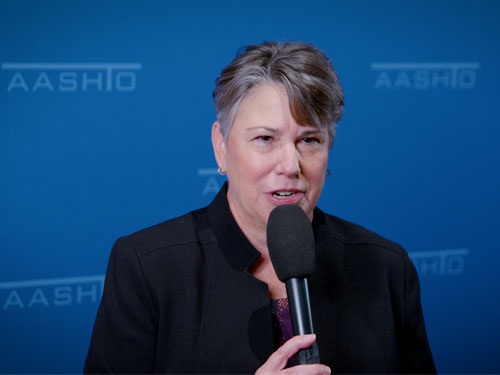An agreement on new federal “reconciliation” legislation unveiled by Senate Majority Leader Chuck Schumer, D-NY, (seen above at right) and Sen. Joe Manchin, D-W. Va., (seen above at left) includes several climate and transportation-related funding measures, with a series of proposed grants and tax credits aimed at boosting equity, alternative vehicle purchases, and environmental review processes for infrastructure projects.
[Above photo by AASHTO]
The 725-page bill – entitled the “Inflation Reduction Act of 2022” – expects to generate $739 billion over 10 years through a combination of corporate tax increases, increased enforcement by the Internal Revenue Service, and drug pricing reform measures.

The legislation proposes to invest $369 billion of those funds in energy and climate change-related measures along with $64 billion to extend Affordable Care Act premium subsidies. An estimated $300 billion of the measure’s funding would go towards federal deficit reduction.
The bill as currently proposed will first be reviewed the Senate’s parliamentarian to conform with budget reconciliation legislation requirements – the so-called “Byrd Rule,” named after the late Sen. Robert Byrd, D-W. Va. – and could be voted on by the Senate next week, with the House following suit shortly thereafter.
Key elements of the bill of interest to state departments of transportation starts on page 699 of the proposed bill text:
- Section 60501: Neighborhood Access and Equity Grant Program. The entire program receives $3 billion for its various initiatives. It provides $1.893 billion at 80 percent federal share to “improve walkability, safety, and affordable transportation access through construction of projects that are context-sensitive” including removal of facilities similar to the Reconnecting Communities Pilot Program within the $1.2 trillion Infrastructure Investment and Jobs Act or IIJA enacted in November 2021. It also provides $1.11 billion at 100 percent federal share for similar activities as above, but specifically to economically disadvantaged communities with a community benefits agreement, anti-displacement policy, and local hiring plan, along with $42 million for technical assistance from the Federal Highway Administration. A key factor in this section is that funding cannot be used for “a project for additional through travel lanes for single-occupant passenger vehicles.”
- Section 60505: Environmental Review Implementation Funds. Provides $100 million “for the purpose of facilitating the development and review of documents for the environmental review process for proposed projects” such as guidance, technical assistance, templates, training, or tools to facilitate an efficient and effective environmental review process for surface transportation projects. That includes any FHWA administrative expenses to conduct such activities. That funding also aims to build capacity of eligible entities and facilitate the environmental review process for proposed projects, including administrative expenses.
- Section 60506: Low-carbon Transportation Materials Grants. Provides $2 billion “to reimburse or provide incentives to eligible recipients for the use of low-embodied carbon construction materials and products in projects,” including FHWA administrative expenses. FHWA may also reimburse non-federal partners for the increased incremental cost of using low-carbon material relative to traditional materials as well as provide an incentive payment of two percent of the cost of using low-carbon materials. However, the reimbursement or incentive cannot cause the federal share to exceed 100 percent and, again, disallows funding for “projects that result in additional through travel lanes for single occupant passenger vehicles.”
Several sections of the proposed bill also bump up fiscal support for alternative vehicles, such as:
- Section 13401: Clean Vehicle Credit (Page 366)
- Section 40007: Alternative Fuel and Low-emission Aviation Technology Program (Page 566)
- Section 60101: Clean Heavy-duty Vehicles (Page 650)
- Section 60102: Grants to Reduce Air Pollution at Ports (Page 653)
 Top Stories
Top Stories
USDOT Makes $1.5B Worth of BUILD Grants Available
December 19, 2025 Top Stories
Top Stories

